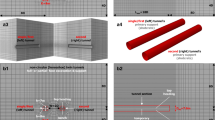Abstract
By quantifying the displacement and crack propagation during the excavation of a new tunnel constructed near an existing tunnel, the influence of the size of the existing tunnel, the distance between tunnel centers, and the earth pressure coefficient, K on the mechanical behavior of existing and new tunnels was investigated and analyzed. A series of experimental model tests was performed and analyzed. It was found that the displacements decreased and stabilized as the distance between tunnel centers increased depending on the size of the existing tunnel. Consequently, a 3.0D distance between tunnel centers for Model Test I and 1.2D for Model Test II are required conservatively to avoid the tunnels being influenced by each other. It was also found that regardless of the distance between tunnel centers, displacements are reduced and hence the stability of the pillar can be secured as the earth pressure coefficient increases. This fundamental insight provides the basis for a more rational design of closely spaced twin tunnels.
Similar content being viewed by others
References
Adachi, T., Kimura, M., and Osada, H. (1993). “Interaction between multitunnels under construction.” Proc. Eleventh Southeast Asian Geotechnical Conference, Singapore, pp. 51–60.
Adhikary, D. P., Dyskin, A. V., Jewell, R., J. and Stewart, D. P. (1997). “A study of the mechanism of flexural toppling failure of rock slopes.” Rock Mech. Rock Engng., Vol. 30, No. 2, pp. 75–93.
Al-Harthi, A. A. and Hencher, S. R. (1995). “Physical and numerical modeling of underground excavations in dilational rock masses.” Proc. 2nd ISRM Conf. on Fractured and Jointed Rock Masses, Lake-Tahoe, USA, pp. 608–615.
Barton, N. (1979). “Model study of very large underground opening at shallow depth.” 4th Cong. of Int. Soc. for Rock Mech., Montreal, Vol. 2, pp. 121–136.
Chapman, D. N., Ahn, S.K., Hunt, D. V. L., and Chan, A. H. C. (2006). “The use of model tests to investigate the ground displacements associated with multiple tunnel construction in soil.” Tunnelling and underground space technology, Vol. 21, No. 3/4, pp. 413–413.
Chu, B. L., Hsu, S. C., Chang, Y. L., and Lin, Y. S. (2007). “Mechanical behavior of a twin-tunnel in multi-layered formations.” Tunnelling and Underground Space Technology, Vol. 22,Issue 3, pp. 351–362.
Dhar, B. B., Ratan, S., Sharma, D. K., and Rao, P. M. (1981). “Model study of fracture around underground excavations.” Proc. The International Symposium on Weak Rock, pp. 267–271.
Fakhimi, A., Carvalhoc, F., Ishidad, T., and Labuze, J. F. (2002). “Simulation of failure around a circular opening in rock.” International Journal of Rock Mechanics & Mining Sciences, Vol. 39,Issue 4, pp. 507–515.
Kamata, H. and Mashimo, H. (2003). “Centrifuge model test of tunnel face reinforcement by bolting.” Tunnelling and Underground Space Technology, Vol. 18,Issue 2–3, pp. 205–212.
Ng, C. W. W., Lee, K. M., and Tang, D. K. W. (2004). “Threedimensional numerical investigations of New Austrian Tunnelling Method (NATM) twin tunnel interactions.” Canadian Geotechnical Journal, Vol. 41, No. 3, pp. 523–539.
Park, S. H. and Adachi, T. (2002). “Laboratory model tests and FE analyses on tunneling in the unconsolidated ground with inclined layers.” Tunnelling and Underground Space Technology, Vol. 17,Issue 2, pp. 181–193.
Sterpi, D. and Cividini, A. (2004). “A physical and numerical investigation on the stability of shallow tunnels in strain softening media.” Rock Mechanics and Rock Engineering, Vol. 37, No. 4, pp. 277–298.
Author information
Authors and Affiliations
Corresponding author
Rights and permissions
About this article
Cite this article
Choi, JI., Lee, SW. Influence of existing tunnel on mechanical behavior of new tunnel. KSCE J Civ Eng 14, 773–783 (2010). https://doi.org/10.1007/s12205-010-1013-8
Received:
Accepted:
Published:
Issue Date:
DOI: https://doi.org/10.1007/s12205-010-1013-8




